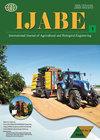A novel method of automatic peeling for Poria cocos based on image processing
IF 2.2
2区 农林科学
Q2 AGRICULTURAL ENGINEERING
International Journal of Agricultural and Biological Engineering
Pub Date : 2023-01-01
DOI:10.25165/j.ijabe.20231602.7044
引用次数: 0
Abstract
: Manual peeling of Poria cocos has low efficiency and large loss, and other peeling methods are not suitable for Poria cocos peeling. To solve this problem, this study designed and fabricated a set of automatic peeling equipment for Poria cocos , which combined image processing technology with the structure and function of the vertical milling machine. This paper mainly reports the image detection algorithm of Poria cocos epidermis position for automatic peeling. Firstly, the blue marks were glued to the movable and the immovable parts of clamping parts, and the initial window was determined through them. Then, the grayscale image within the initial window was obtained with the help of the chromatic aberration |2 r - g - b | (red ( r ), green ( g ), blue ( b ) of pixels). The processing window was calculated with the aid of the distribution graph of the grayscale accumulation. Next, the grayscale image was taken into the process of the automatic binarization based on the Otsu method and the binary image was restored through dilation, erosion and denoising algorithm. Finally, pixel columns in the processing window were scanned column-by-column from the left to the right and the direction of each pixel column is from the bottom to the top. The first pixel with a value of 0 on each pixel column was set as the epidermis position of the current pixel column. The experiment results implied that, under the set light source, the average detection accuracy was 98.8%, and the average time to detect epidermis position once was 0.024 s. The detection accuracy and real-time performance of this algorithm meets the actual operation requirements of Poria cocos peeling. It lays the foundation for the automatic peeling operation of Poria cocos .一种基于图像处理的茯苓自动去皮方法
:手工去皮茯苓效率低,损耗大,其他去皮方法不适合茯苓去皮。为了解决这一问题,本研究将图像处理技术与立式铣床的结构和功能相结合,设计制作了一套茯苓自动去皮设备。本文主要报道了茯苓表皮自动脱皮位置的图像检测算法。首先在夹紧件的活动部件和不可活动部件上粘贴蓝色标记,通过它们确定初始窗口。然后,借助像素的色差| 2r - g - b |(红(r),绿(g),蓝(b)),得到初始窗口内的灰度图像。利用灰度累积分布图计算处理窗口。其次,将灰度图像纳入基于Otsu方法的自动二值化过程中,通过膨胀、侵蚀和去噪算法恢复二值化图像。最后,从左到右逐列扫描处理窗口中的像素列,每个像素列的方向从下到上。将每个像素列上值为0的第一个像素设置为当前像素列的表皮位置。实验结果表明,在设定的光源下,平均检测准确率为98.8%,一次检测表皮位置的平均时间为0.024 s。该算法的检测精度和实时性满足茯苓去皮的实际操作要求。为茯苓自动去皮操作奠定了基础。
本文章由计算机程序翻译,如有差异,请以英文原文为准。
求助全文
约1分钟内获得全文
求助全文
来源期刊

International Journal of Agricultural and Biological Engineering
AGRICULTURAL ENGINEERING-
CiteScore
4.30
自引率
12.50%
发文量
88
审稿时长
24 weeks
期刊介绍:
International Journal of Agricultural and Biological Engineering (IJABE, https://www.ijabe.org) is a peer reviewed open access international journal. IJABE, started in 2008, is a joint publication co-sponsored by US-based Association of Agricultural, Biological and Food Engineers (AOCABFE) and China-based Chinese Society of Agricultural Engineering (CSAE). The ISSN 1934-6344 and eISSN 1934-6352 numbers for both print and online IJABE have been registered in US. Now, Int. J. Agric. & Biol. Eng (IJABE) is published in both online and print version by Chinese Academy of Agricultural Engineering.
 求助内容:
求助内容: 应助结果提醒方式:
应助结果提醒方式:


